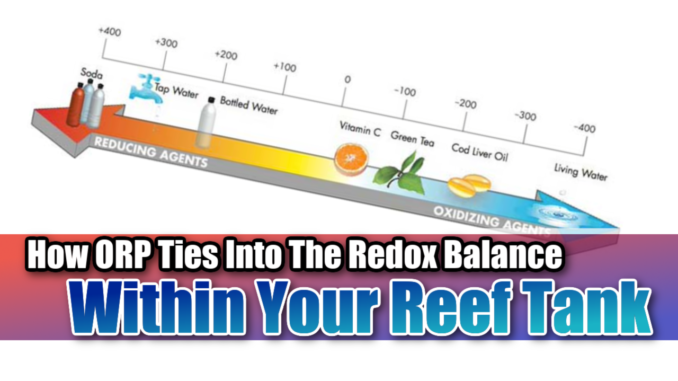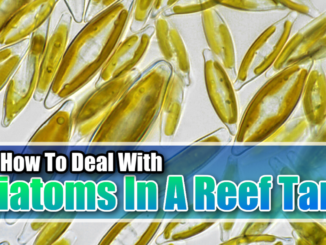
Oxidation-Reduction Potential (ORP) is a measurement closely tied to the concept of redox balance. ORP is a way to quantify the electron transfer capacity of a solution, indicating the level of oxidizing or reducing agents present. In simpler terms, ORP provides insights into the overall redox state of a liquid, including the water in your reef tank.
Here’s how ORP ties into the concept of redox balance within your reef tank:
- ORP Measurement: ORP is measured in millivolts (mV) and gives you an idea of how “electron-hungry” or “electron-rich” the water is. Positive ORP values indicate oxidizing conditions, while negative values suggest reducing conditions.
- Oxidation and Reduction: Positive ORP values typically correspond to water that has more oxidizing agents, meaning it’s more likely to accept electrons from other substances. Negative ORP values indicate water that has more reducing agents, which are more likely to donate electrons.
- Redox Balance and Water Quality: Monitoring ORP is a way to assess the redox balance in your reef tank’s water. A balanced and healthy tank often has stable ORP readings, which suggest a well-maintained redox environment.
- Oxygen and ORP: Oxygen content is a significant factor influencing ORP. Water with higher dissolved oxygen levels usually has a positive ORP, as oxygen is an oxidizing agent. Adequate oxygenation contributes to a balanced redox state in the water.
- Biological Activities: ORP can reflect the biological activities occurring in the tank. Healthy aerobic (oxygen-loving) processes tend to result in higher ORP values, while anaerobic (low-oxygen) conditions might lead to lower ORP values.
- Nutrient Cycling: ORP can indirectly influence nutrient cycling in the tank. Balanced redox conditions contribute to the efficient breakdown of waste and the cycling of nutrients, which in turn supports the health of the ecosystem.
- Monitoring Redox Stability: Fluctuations in ORP readings can indicate changes in redox balance. Drastic shifts can be a sign of environmental stressors or imbalances within the tank that may require attention.
- Tank Health: Maintaining stable ORP values is a goal for reef tank health. It indicates that the tank’s ecosystem is functioning well, supporting the well-being of corals, fish, and other inhabitants.
ORP is a valuable tool that provides insights into the redox balance of your reef tank. It’s like a measurement of the tug-of-war between substances that give and take electrons.
Monitoring ORP can help you ensure that your tank’s environment is conducive to the growth and thriving of the livestock in your reef tank. It’s one of the ways you can gauge the health and balance of your aquatic ecosystem.
Healthy ORP levels for a reef tank can vary depending on several factors, including the specific setup of your tank, the types of inhabitants you have, and the overall water quality. Generally, ORP levels for a reef tank should fall within a range that indicates a balanced and stable redox environment.
For most reef tanks, a target ORP range of approximately 350 to 450 millivolts (mV) is often considered healthy. However, it’s important to note that the specific range can vary slightly based on individual tank characteristics and the preferences of experienced reefkeepers.
Here’s a breakdown of ORP levels and their implications:
- High ORP (Above 450 mV): Very high ORP levels can indicate an overly oxidizing environment. While some oxidation is necessary to maintain water quality, excessively high ORP might suggest an imbalance or excessive use of chemical oxidizers. This could potentially stress the tank’s inhabitants.
- Optimal ORP (350 to 450 mV): Most reef tanks thrive within this range. It suggests a balanced redox environment, where oxidation and reduction processes are occurring naturally and supporting the health of the ecosystem.
- Low ORP (Below 350 mV): Consistently low ORP levels could indicate an overly reducing environment. While some reducing conditions can be beneficial in certain areas of the tank (such as anaerobic zones in the substrate), very low ORP might suggest issues with water quality or excessive organic material buildup.
It’s important to remember that ORP is just one aspect of water quality and should be considered alongside other reef tank parameters like pH, temperature, ammonia, nitrate, and phosphate levels. Additionally, sudden and drastic changes in ORP readings might indicate an issue that needs attention, but minor fluctuations can be normal as long as they return to a stable range.
Keep in mind that each tank is unique, and factors like equipment, inhabitants, and maintenance routines can influence ORP readings. Regular monitoring of ORP, along with other water parameters, is crucial for maintaining a healthy and thriving reef tank. .




